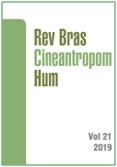Training aimed at the development of power and physical performance of futsal players
DOI:
https://doi.org/10.1590/1980-0037.2019v21e60119Abstract
The aim of the study was to analyze the effect of a training period aimed at the development of lower limb power and physical performance of futsal players. The sample consisted of 10 futsal players from a professional team aged 23.70 ± 5.85 years, 72.33 ± 6.01 kg and 174.40 ± 0.05 cm. Players were monitored for a period of 4 training weeks, corresponding to the beginning of the competitive period. During this period, physical training sought to improve lower limb power. At the beginning and end of the training period, the following tests were performed: Squat jump (SJ), Countermovement jump (CMJ), 15-meter speed (Vel_15m) and Futsal Intermittent Endurance Test (FIET). The training load was monitored by the Session Perceived Exertion method. Weeks 1 and 3 presented higher training load than weeks 2 and 4 (p <0.01). In the post-training period, shorter running time in the Vel_15m test (p = 0.04), greater height in SJ (p <0.01) and CMJ (p <0.01) tests, and higher maximal speed in FIET (p = 0.04) were observed. It could be concluded that directing training at the beginning of the competitive season to improve power increases the lower limb power of futsal players, with consequent improvement of speed and the ability to perform intermittent actions at high intensities.
References
Beato M, Coratella G, Schena F. Brief review of the state of art in futsal. J Sports Med Phys Fitness 2016;56(4):428-32.
Barbero-Alvarez JC, Soto VM, Barbero-Alvarez V, Granda-Vera J. Match analysisand heart rate of futsal players during competition. J Sports Sci 2008;26(1):63-73.
Bueno MJ, Caetano FG, Pereira TJ, De Souza NM, Moreira GD, Nakamura FY, et al. Analysis of the distance covered by Brazilian professional futsal players during official matches. Sports Biomech 2014;13(3):230-40.
Castagna C, D’Ottavio S, Granda Vera J, Barbero Alvarez JC. Match demands of professional Futsal: a case study. J Sci Med Sport 2009;12(4):490-4.
Naser N, Ali A, Macadam P. Physical and physiological demands of futsal. J Exerc Sci Fitness 2017;15(2):76-80.
Makaje N, Ruangthai R, Arkarapanthu A, Yoopat P. Physiological demands and activity profiles during futsal match play according to competitive level. J Sports Med Phys Fitness 2012;52(4):366-74.
Nogueira FC, De Freitas VH, Nogueira RA, Miloski B, Wernek FZ, Bara-Filho MG. Improvement of physical performance, hormonal profile, recovery-stress balance and increase of muscle damage in a specific futsal pre-season planning. Rev Andal Med Deporte 2018;11(2):63-8.
Matveyev LP. Modern procedures for the construction of macrocycles Modern. Mod Athlete Coach 1992;30:32-4.
Miloski B, de Freitas VH, Bara-Filho MG. Monitoramento da carga interna de treinamento em jogadores de futsal ao longo de uma temporada. Rev Bras Cineantropom Desempenho Hum 2012;14:671-9.
Moreira A. The training periodization and the emerged questions: the team sports’case. Rev Andal Med Deporte 2010;3(4):170-8.
Freitas VH, Miloski B, Bara-Filho MG. Quantification of training load using session RPE method and performance in futsal. Rev Bras Cineantropom Desempenho Hum 2012;14(1):73-82.
de Freitas VH, Pereira LA, de Souza EA, Leicht AS, Bertollo M, Nakamura FY. Sensitivity of Yo-Yo IR and Cardiac Autonomic Responses to Training in Futsal Players. Int J Sports Physiol Perform 2015; 10(5):553-8.
Miloski B, de Freitas VH, Nakamura FY, de ANFC, Bara-Filho MG. Seasonal Training Load Distribution of Professional Futsal Players: Effects onPhysical Fitness, Muscle Damage and Hormonal Status. J Strength Cond Res 2016;30(6):1525-33.
Soares-Caldeira LF, de Souza EA, de Freitas VH, de Moraes SM, Leicht AS, Nakamura FY. Effects of additional repeated sprint training during preseason on performance, heart rate variability, and stress symptoms in futsal players: a randomized controlled trial. J Strength Cond Res 2014;28(10):2815-26.
Loturco I, Pereira LA, Kobal R, Zanetti V, Gil S, Kitamura K, et al. Half-squat or jump squat training under optimum power load conditions to counteract power and speed decrements in Brazilian elite soccer players during the preseason. J Sports Sci 2015;33(12):1283-92.
Foster C, Florhaug JA, Franklin J, Gottschall L, Hrovatin LA, Parker S, et al. A newapproach to monitoring exercise training. J Strength Cond Res 2001;15(1):109-15.
Castagna C, Barbero Alvarez JC. Physiological demands of an intermittent futsaloriented high-intensity test. J Strength Cond Res 2010;24(9):2322-9.
Borg G, Hassmen P, Lagerstrom M. Perceived exertion related to heart rate and blood lactate during arm and leg exercise. Eur J Appl Physiol Occup Physiol 1987;56(6):679-85.
Meckel Y, Doron O, Eliakim E, Eliakim A. Seasonal Variations in Physical Fitnessand Performance Indices of Elite Soccer Players. Sports 2018;6(1): 14.
de Freitas VH, Nakamura FY, de Andrade FC, Pereira LA, Coimbra DR, Bara-Filho M. Pre-competitive physical training and markers of performance, stress and recovery in young volleyball athletes. Rev Bras Cineantropom Desempenho Hum 2015;17(1):31-40.
Loturco I, Contreras B, Kobal R, Fernandes V, Moura N, Siqueira F, et al. Vertically and horizontally directed muscle power exercises: Relationships with top-levelsprint performance. PLoS One 2018;13(7):e0201475.
Loturco I, Pereira LA, Kobal R, Zanetti V, Kitamura K, Abad CC, et al. Transference effect of vertical and horizontal plyometrics on sprint performance of high-levelU-20 soccer players. J Sports Sci 2015;33(20):2182-91.
Wong PL, Chamari K, Wisloff U. Effects of 12-week on-field combined strength and power training on physical performance among U-14 young soccer players. J Strength Cond Res 2010;24(3):644-52.



